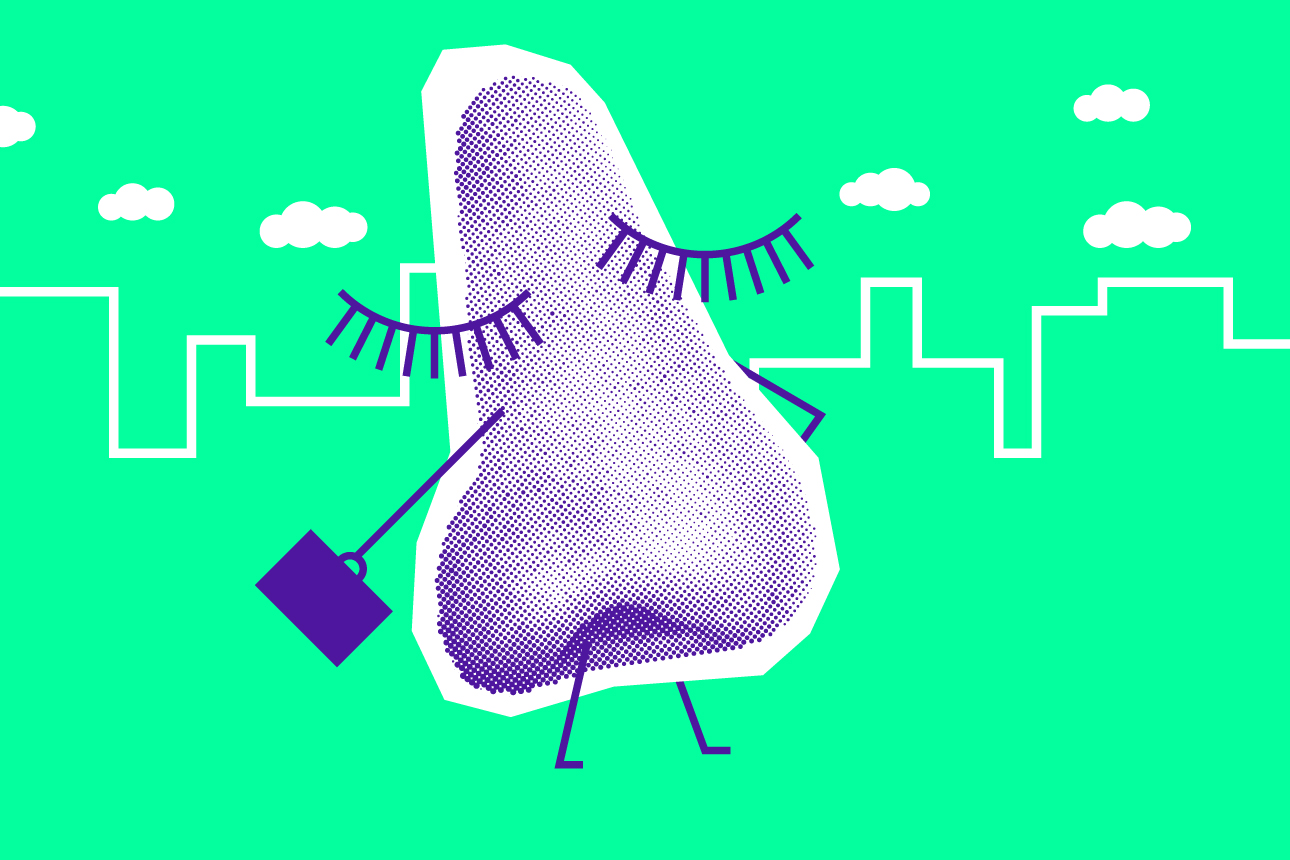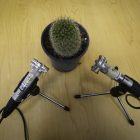Two emerging branches of digital olfaction technology have the potential to revolutionize a range of industries.
The aroma of freshly baked bread wafting through supermarket aisles. The percolating pot of coffee in a house for sale. The leathery richness of a new car’s interior. We may not always realize it, but our sense of smell is central to many decisions we make as consumers, be it purchasing a new car or deciding to grab a doughnut and coffee on the run. According to the Scent Marketing Institute, leather and cedar aromas will induce you to buy furniture, and floral and citrus notes will make you linger longer in the bookshop. One study showed that adding ambient scents to a Nike showroom increased consumers’ pleasure and stimulation, willingness to spend more money, and likelihood of returning to the store, compared with a nonscented environment.
Put simply, smell sells — a fact that has long been understood by retailers, manufacturers, and advertisers. But despite the economic and commercial importance of olfaction, businesses have generally lacked robust tools to detect, measure, and manage smells in a scientific way. This is now changing with the emergence of two branches of digital olfaction technology: one focused on the digital detection and analysis of different odors, and the other on the digital transmission and re-creation of smells. These technologies could potentially revolutionize a range of industries, from fragrances and food to the environmental and health care sectors.
A variety of innovative startups are pioneering new approaches to digital olfaction. The technology draws on a raft of scientific disciplines, including organic chemistry, silicon engineering, machine learning, data science, photonics, and software engineering. Aryballe, a digital olfaction startup based in France, uses tiny proteins called peptides grafted onto silicon wafers that react to the gas molecules associated with different odors. The various digital signatures are then decoded using machine learning and expressed in the terms that humans use to describe smells: woody, floral, fragrant, smoky, and so on. Aromyx, a digital olfaction company based in California, uses the same receptors that are found in the human nose and tongue to identify different odors. CEO Josh Silverman told us: “Rather than trying to mimic the human sense of smell — a very hard problem — we clone the actual genes from humans. We then develop these in the lab and test how different genes respond to different stimuli, such as coffee and juice.”
Applications of Digital Olfactory Detection
In addition to enhancing products’ appeal to consumers, emerging olfactory technologies support a variety of use cases for improved product quality, as well as human health and safety, in areas as diverse as food, auto maintenance, health care, and the environment.
Faster and cheaper quality control. Digital olfaction is starting to transform quality control, traditionally a labor-intensive and somewhat subjective activity for many industries. Take the example of the global fragrance industry, estimated to be worth around $71 billion, which encompasses perfumes as well as deodorants, personal care products, and household care products such as air fresheners and scented candles. Traditionally, teams of highly trained human testers have assessed the quality of different product batches, but the process is time-consuming and ultimately subjective. Here, companies such as Aryballe are using digital olfaction to test different fragrances against a “gold standard” for the particular scent. As Sam Guilaume, CEO of Aryballe, explained: “A fragrance will usually change as it’s exposed to the air or to different conditions. With digital olfaction, we can track how the perfume changes over time as it’s exposed to different kinds of skin types, sweat, air conditions, and so on. Once we know what works, we can also potentially create completely new fragrances that have the desired qualities.”
Food quality control could also benefit greatly. Digital olfaction can be used to identify minute variations in the quality of food products and detect pathogens that could endanger human health or lead to food spoilage during supply chain transport. Olfactory technologies are already being used to screen for salmonella in packaged meat products. Digital olfaction can also greatly aid the search for better and healthier foods. As Silverman explains, “Many manufacturers want to make a healthier beverage — less sugar, alcohol, calories — but they want to do that in a way that doesn’t turn consumers off and doesn’t cost more. Digital olfaction can help with this kind of problem.”
Enabling the smart home. Some of the most practical applications of digital olfaction detection are in the home. A truly smart fridge, for example, could tell you when the milk is about to turn sour or when that loin of beef has aged to perfection. Olfactory sensors in an oven could roast food to your specifications or prevent it from being overcooked. Google Nest Protect uses sensors to distinguish between different kinds of smoke to avoid irritating false alarms while you make toast or take a steamy shower.
Calibrating regional tastes. Many retailers and manufacturers recognize scent as an important factor influencing the consumer appeal of a product, but the consumer-scent relationship varies greatly by region and country, making it difficult to calibrate and measure. Take the automotive industry, for example. Car showrooms have long known that the new-car smell influences our decision to purchase, but there are strong regional differences: While the intoxicating aromas of leather, resins, and plastics tend to captivate European and American car buyers, it is a distinct turnoff in Asia, where consumers prefer a more neutral odor. Digital olfaction can help optimize the new-car aroma for different markets. Consider, too, how perfume preferences vary by country. In Japan, for example, strong scents are generally frowned upon, whereas in other countries, there is a preference for distinctive, musky signatures. Digital olfaction can help calibrate these olfactory notes to different regional and local preferences.
Predictive maintenance. The phrase “something doesn’t smell right” usually signifies a gut feeling that there’s a problem. In fact, digital olfaction can be used in a range of industries to detect problems before they become apparent, improving safety and reducing the risk of costly unscheduled repairs. The technology is already being deployed in the car-sharing industry, where olfactory sensors in vehicles can detect burnt fuses or wiring before they become apparent to a human driver. They can also pick up on food spills or cigarette smoke left behind by car sharers that would otherwise be difficult to detect. In industrial sectors, olfactory technologies can alert people to the presence or buildup of dangerous gases in chemical plants or processing centers and detect emerging leaks in oil or gas pipelines.
Early diagnosis and prevention in health care. We humans have long believed that our olfactory senses provide important clues to our well-being, both physical and mental. Ancient physicians used to smell a sick person’s breath to identify their illness. More recently, research has established that canines can detect the early presence of diseases such as lung cancer via breath and urine. Electronic noses have been shown to be around 96% accurate in detecting lung cancer in patients. Recent research has suggested that digital olfaction could provide a quick and safe test for the detection of COVID-19.
These developments open up the tantalizing prospect of low-cost, noninvasive technology to screen for a wide range of diseases and viruses, particularly those that are hard to detect with conventional early-stage screening. In the future, you could potentially breathe into your smartphone to get an instant health check or wear a mask that automatically lights up when coming into contact with the coronavirus.
Reducing environmental impacts. Companies and government agencies spend billions of dollars every year to control or eliminate noxious odors in the environment. Digital olfaction makes it possible to detect, monitor, and reduce such emissions at lower cost. Bio-electronic noses can identify harmful pollutants in factories or urban areas, assess water quality, measure soil contamination, and check for chemicals or hazardous materials in warehouses and harbors.
Digital olfaction can also increase the effectiveness of recycling initiatives, a key plank of the move toward a circular economy. According to Aromyx’s Silverman, “Being able to recycle plastics makes a huge difference to the environment, but often these plastics contain contaminants and off smells from their original use. We can use digital olfaction to isolate these off smells and ultimately remove them.”
Digital Transmission of Scents
In a nascent area of olfactory research, scents are digitally transmitted via computer code that can be sent online or via smartphone app and reproduced at a kiosk or through a scent-emitting device. Previous attempts to re-create scents have faced challenges because liquid or gaseous odorants often contaminate each other. The Aroma Shooter, developed by Japanese startup Aromajoin, gets around this problem through the use of solid-state materials that can deliver split-second volleys of over 400 different scents. The technology is now being used to create “aroma signage” in major department stores and to improve virtual-reality applications. Another Japanese startup has developed the Scentee Machina, a device that connects to a smartphone app that can diffuse different fragrances according to the user’s mood and the time of day. Researchers at All These Worlds, a VR company based in California, have developed a wireless-enabled scent collar that releases targeted scents for virtual reality simulations.
One frontier area of application is the use of digital scents in mental health treatment. Research has shown that our moods are greatly affected by different odors: Lavender can reduce labor pangs in childbirth and promote sleep; peppermint can improve physical performance; and orange may help calm our nerves. One study showed how low-cost nasal clips containing lavender odorants could improve the quality of sleep for people with post-traumatic stress disorder.
Digital olfaction also opens up the possibility of bringing the past to life through the re-creation of long-lost smells — the spices and incense of the Roman Forum in early medieval times, for example, or the soot and smoke of Dickensian London. Researchers at the UCL Institute for Sustainable Heritage in London are re-creating and preserving “historical” scents that could otherwise be lost, such as the dusty smell of old books. An organization called Sensory Maps is creating olfactory maps of cities, both current and historical, that can then be virtualized using digital design, animation, and scent diffusion. Such maps can help us understand changing patterns of social and economic activity within cities and contribute to better urban planning and design.
Digital olfaction also opens up the possibility of completely new smells and products algorithmically optimized to personal tastes and different settings. Combined with other technologies such as VR and haptics, digital olfaction could radically transform the entertainment industry, bringing us closer to a true multisensory experience in the realms of fashion, retailing, leisure, and tourism. Imagine taking in the aroma of products while shopping online, or imbibing the sea air on a virtual reality tour of the Maldives. Imagine a transformed book-reading experience (and transformed publishing industry) as virtual reality and digital olfaction complement classic books: the vinegary tang of fish and chips in Brighton Rock, the sweet rose aroma of Turkish delight in The Chronicles of Narnia, or the whitewashing paint in The Adventures of Tom Sawyer.
Capturing the Potential of Digital Olfaction
How can companies better capitalize on the promise of digital olfaction and avoid the potential pitfalls? We suggest four actions that can help guide businesses:
Understand your olfactory value chain. Companies can start by mapping their olfactory value chain to identify the role that olfaction plays across the different areas of their business. A fast-moving consumer goods company, for example, could have thousands of product lines ranging from food to household detergents; scents are an intrinsic part of these products’ appeal to customers but remain largely unquantified. In some industries — such as wine or fragrance production — digital olfaction can complement the tacit knowledge of experienced tasters or product formulators. Olfactory mapping can trace how a product’s olfactory features vary across the supply chain, over time, and across different locations — from farm to fork in food products, for example. Such profiling can improve product development strategies and supply chain optimization and ultimately garner a stronger competitive advantage through distinctive customer appeal.
Prepare for contestable markets. As digital olfaction begins to decode the volatile organic compounds that contribute to our sense of smell, it introduces the possibility of reverse-engineering many well-known or distinctive aromas. Just as digital technologies are lowering entry barriers in many markets and making them “contestable” with new products, we may see something similar with digital olfaction. Copycat versions of products with distinctive or hard-to-replicate aromas — perfumes, fine wines, furniture, cheeses, teas and coffee, and even fast foods — could proliferate. Companies will need to expend effort to preserve the intangible capital of their olfactory signatures.
Consider multiple senses. In real life, our experiences are formed from a range of senses. Digital olfaction will be most powerful when combined with other sensory technologies such as virtual and augmented reality, haptics, holograms, and emotional AI systems. Sensors and machine learning algorithms will be critical in capturing, decoding, and translating olfactory signals to human experiences. As Silverman explained: “Using just over 400 working olfactory receptors, you can differentiate over a trillion different odors. This implies that there is a high-dimensional space that the human brain is generating with these receptors. We need machine learning to disentangle these spaces, and then we need natural language processing to translate those combinations into terms humans understand — nutty or toasted, for example. Ultimately, our aim is to create a kind of Rosetta stone for the sense of smell.”
Anticipate ethical and regulatory hurdles. Despite the promise of olfactory technology, there are technical, ethical, and regulatory challenges to surmount. A particular concern is the potential for addiction as ever more powerful olfactory triggers are developed; at the other extreme, overexposure could lead to the desensitization of people exposed to powerful scents on a daily basis, just as loud music has caused hearing loss for some in the entertainment or hospitality industries. Early engagement with regulators and health authorities will be critical, both to mitigate the risks and promulgate the health-enhancing effects of digital olfaction.
Smell is our most primordial sense, used by our ancestors to forage for food, sense danger, and detect illnesses. Yet it remains the most complex and least well understood of all the senses — the human olfactory receptors were only identified in 1991, earning a Nobel Prize for the scientists who made the discovery. With advances in digital olfaction, we now have the ability to decode and harness the sense of smell in ways never thought possible.
For businesses, digital olfaction opens up many opportunities: new products, services, and consumer experiences; faster and more accurate production processes; low-cost environmental and health care solutions; and new ways to reach and engage consumers. There will be challenges, too: regulation, responsible use, and new competitors and business models. Now is the time to consider how digital olfaction can help your business capture the sweet smell of success.
Source: Business Scents: The Rise of Digital Olfaction | MIT Sloan Management Review

Humans can ‘smell’ each other’s emotions | Livescience

Why Do Smells Trigger Such Powerful Memories? | Discover Magazine





















